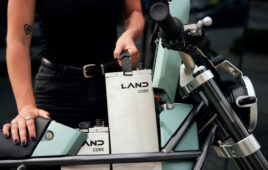
In the future, indoor aluminum surfaces might be cost-effectively coated with paints based on potato starch. Photo copyright Fraunhofer IAP.
For surfaces that need corrosion protection, 80% of the time that’s accomplished through a paint or varnish coating. Unfortunately, the proportion of bio-based, environmentally-friendly solutions in this space is quite small. Researchers at the Fraunhofer Institute for Applied Polymer Research IAP, in cooperation with the Fraunhofer Institute for Manufacturing Engineering and Automation IPA, are looking to close this gap and are developing a cost-effective coating based on renewable raw materials. And the surprising focus of their research? Potato starch.
In Germany alone, 100,000 tons of coating materials for protection against corrosion are produced every year. However, paints and varnishes with bio-based binders or film formers have usually been too expensive or could not meet green requirements. But through the use of modified starch, scientists at Fraunhofer IAP have found a sustainable and cost-effective solution.
“Until now, traditional industrial fields of application of starch have been the paper/corrugated cardboard and adhesives industries,” said Christina Gabriel, a scientist at the Fraunhofer IAP in Potsdam-Golm. “In the field of paints and varnishes on the other hand, starch was usually only used as an additive. With starch as the main component of a water-based dispersion, we now have very promising adhesion results.”
“Film formers must fulfill several tasks. They must form a continuous film, which adheres well to the substrate material, is compatible with additional layers and additives and can embed pigments and fillers as well,” said Gabriel. “In its natural form, however, starch exhibits several properties, which stand in the way of its use as a film former. For example, it is not soluble in cold water and neither does it form continuous, non-brittle films. We therefore had to modify the starch to adapt it to the requirements.”
The solution, which involves esterification, results in starch esters that are dispersible in water, form continuous films and have very good adhesive properties on glass and aluminum surfaces. In cooperation with the Fraunhofer IPA, the esterified starch is then “crosslinked,” through which the sensitivity of the coating to water is reduced further.
Tests check the long-term stability of coated materials by exposing them to rapidly changing temperature cycles in a time-compressed form—this simulates the day/night cycle and the seasons. Test objects are also exposed to electrolyte-enriched water to see how the coating reacts to water—and how resistant it is under extreme conditions.
New “recipes” are also being tested, so as to optimize the properties of the coating even further.
“Apart from the already tested aluminum, two other important metals, steel and galvanized steel, are to be tested,” said Gabriel. “Our investigations show that with its good film forming and very good adhesion properties on various substrates, starch esters have the potential to be future alternatives to petroleum-based film formers in the coatings industry.”
Fraunhofer IAP
iap.fraunhofer.de/en
Filed Under: Green engineering • renewable energy • sustainability




